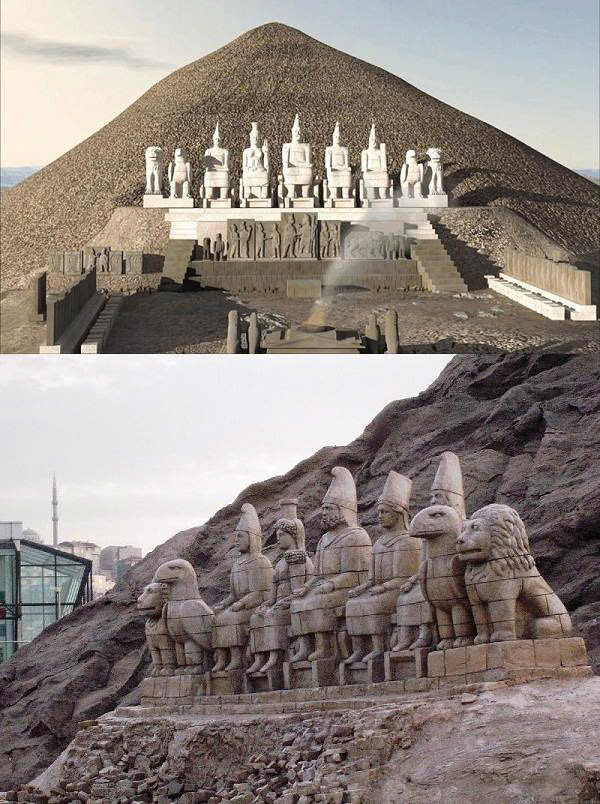Nestled on the picturesque slopes of Mount Nemrut in Adıyaman, Turkey, the Hierothesion stands as an enduring symbol of the rich cultural heritage of the ancient Kingdom of Commagene. This extraordinary site, designated as a UNESCO World Heritage site, dates back to the 1st century BCE. It was commissioned by King Antiochus I as a grand funerary monument and sanctuary. Blending artistic and architectural elements from Greece, Persia, and Anatolia, the Hierothesion reflects a harmonious synthesis of these diverse traditions, creating a marvel that has fascinated scholars and visitors alike.

Among the most remarkable features of the Hierothesion are the colossal statues that dominate its three terraces. These statues serve as a vivid representation of the cultural and religious diversity that characterized the Commagene Kingdom. On the eastern terrace, visitors encounter breathtaking sculptures of Greek deities such as Apollo and Zeus, which highlight the influence of Hellenistic culture on the region. Alongside these figures, the Persian sun god Mithra is prominently depicted, emphasizing the kingdom’s deep-rooted connections to Persian traditions. Intriguingly, the sculptures also include a portrayal of King Antiochus I himself, immortalized in a god-like form, symbolizing his aspirations to bridge the spiritual and temporal realms.
The western terrace is equally awe-inspiring, featuring statues of the goddess Tyche, revered as the embodiment of the city’s fortune, and the enigmatic “Lion Horoscope.” This celestial symbol interweaves elements of Anatolian and Mesopotamian iconography, providing a unique glimpse into the ancient peoples’ cosmological understanding. Towering up to 10 meters in height, these monumental sculptures are a testament to the exceptional craftsmanship of the artisans who brought them to life. The intricate details carved into each figure reveal a level of artistic sophistication that remains impressive even by today’s standards.
The arrangement of these statues on the terraces of Mount Nemrut suggests a deliberate alignment with celestial movements. Oriented towards the eastern horizon, the statues highlight the significance of astronomy and astrology in the religious and cultural practices of the Commagene people. Positioned at an altitude of 2,150 meters, the site offers unparalleled views of the surrounding landscape and the heavens above. This strategic placement enhances the site’s mystical and divine ambiance, inviting contemplation on humanity’s relationship with the cosmos.
In modern times, the Hierothesion has attracted considerable academic and public attention. Researchers and historians have made significant strides in uncovering the layers of meaning embedded in the site’s architecture and artwork. By employing cutting-edge digital technologies, they have created detailed graphic recreations and virtual reconstructions of the monument. These innovations allow a global audience to appreciate the grandeur of the Hierothesion, even as the physical site endures the wear of time and environmental conditions. Such technological advancements ensure that the legacy of this ancient marvel is preserved for future generations to study and admire.
The ambitious vision of King Antiochus I for the Hierothesion becomes increasingly apparent through these modern explorations. The site’s combination of colossal statues, intricate bas-reliefs, and thoughtfully designed sacred spaces offers a captivating glimpse into the ruler’s dedication to forging a unique cultural identity for his kingdom. By drawing inspiration from Greco-Roman, Persian, and Anatolian traditions, Antiochus I sought to create a monument that would not only honor the gods but also solidify his legacy as a ruler who celebrated cultural exchange and unity.
Today, the Hierothesion remains a powerful reminder of the enduring legacy of ancient civilizations and their capacity for artistic and architectural innovation. Its imposing presence on Mount Nemrut serves as a testament to the resilience of human creativity, even in the face of political and social upheaval. As a symbol of cultural synthesis, the Hierothesion continues to inspire awe and reverence, encouraging us to reflect on the shared heritage that connects humanity across time and space.
Through its towering statues, elaborate artistic motifs, and panoramic vistas, the Hierothesion captures the imagination of all who encounter it. The site not only offers a window into the spiritual beliefs and artistic achievements of the ancient Commagene Kingdom but also stands as a testament to the enduring power of cultural collaboration. In a world often divided by differences, the Hierothesion reminds us of the beauty that emerges when diverse traditions come together to create something truly extraordinary.
The ongoing efforts to study and preserve the Hierothesion underscore its importance as a cultural and historical treasure. Scholars continue to delve into its mysteries, seeking to unravel the stories and symbolism enshrined within its monumental art and architecture. With every discovery, our understanding of this remarkable site deepens, shedding new light on the people who once called the Kingdom of Commagene their home.
As we look to the future, the Hierothesion’s legacy endures not only as an archaeological marvel but also as an emblem of the human spirit’s capacity for creativity and innovation. It invites us to consider the ways in which we, too, can contribute to the preservation and celebration of our shared cultural heritage. In doing so, we honor the vision of King Antiochus I and the artisans who brought his dream to life, ensuring that the Hierothesion remains a source of inspiration for generations to come.





